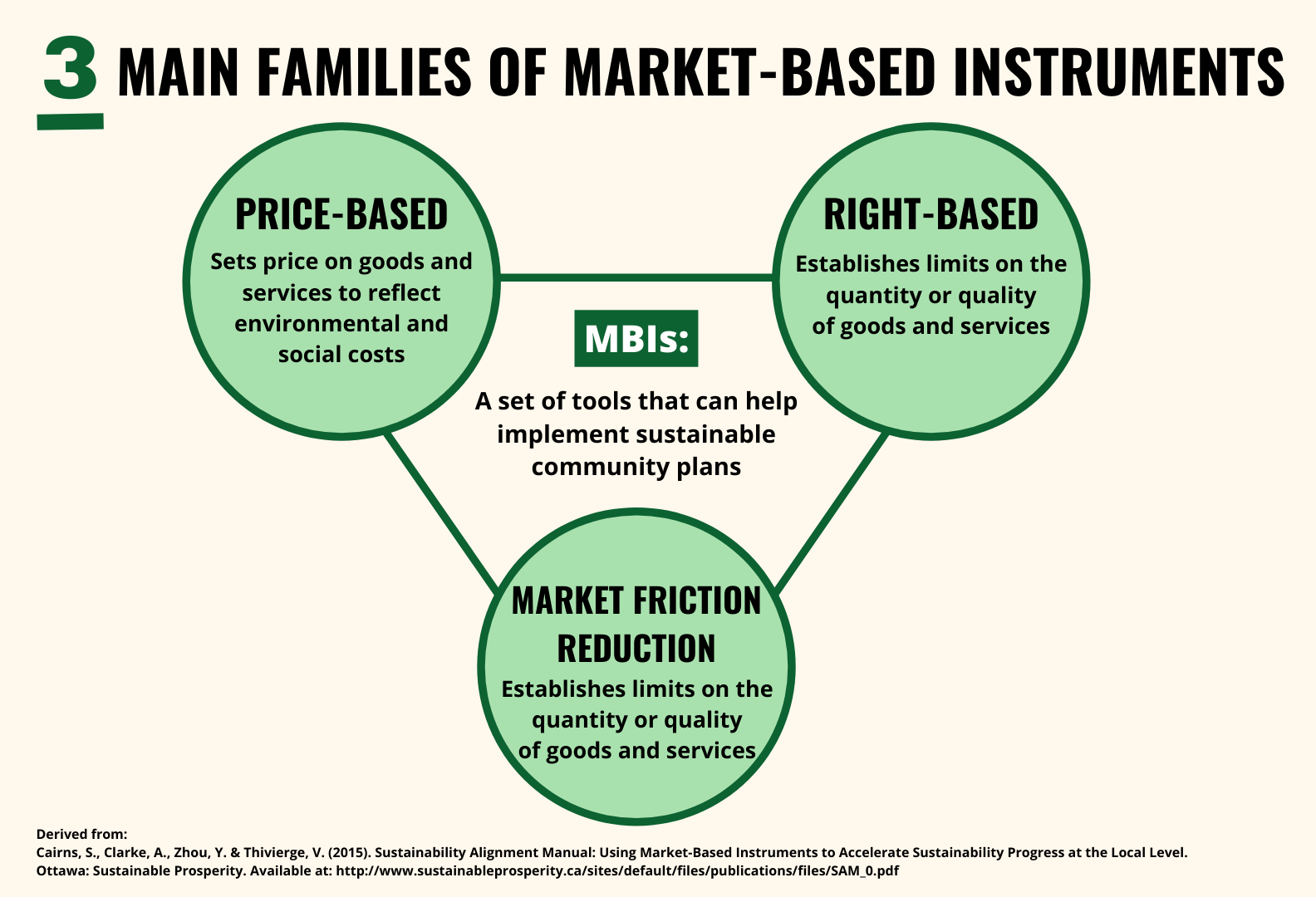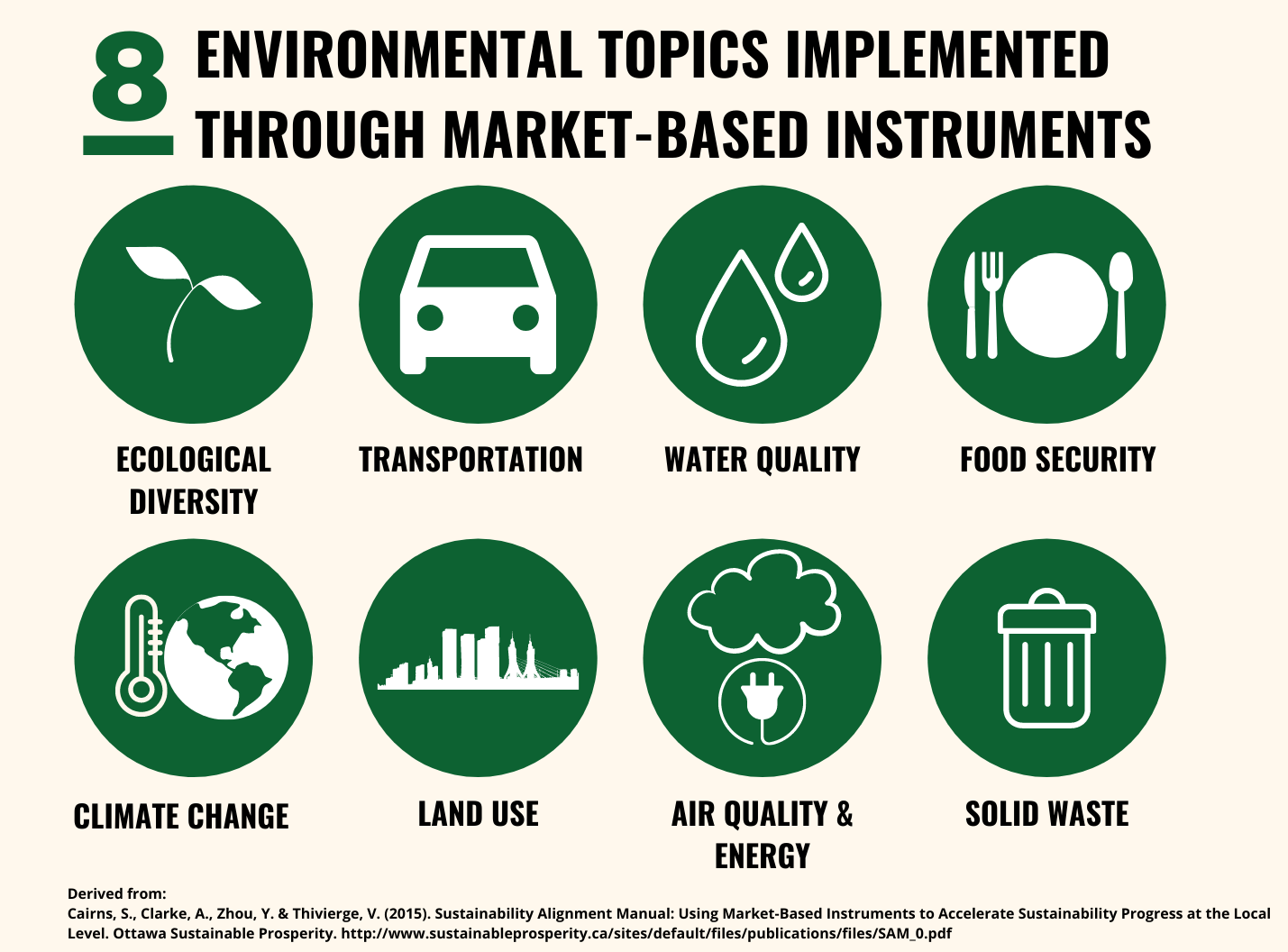Many local governments have adopted a sustainable community plan. One way to implement these plans is through market-based instruments (MBIs). This approach complements a regulatory approach. MBIs are tools that alter economic signals to provide incentives to achieve a stated goal.
MBIs can be broadly classified into three types:
Price-based instruments: With price-based instruments, governments set or adjust the price of goods and services to reflect relative environmental and social costs. The price may be expressed as a subsidy or a cost, to reflect environmental and social benefits or environmental negative impacts. For example, public transit pricing, water pricing, development charges, etc.
Rights-based instruments: With rights-based instruments, governments establish limits on the quantity or quality of goods and services. The limits determine the type of goods and services produced. Revenue can be generated through the selling or auctioning of rights. Examples of this are tradable permits for water, bag tag programs for waste, and licensing parking spaces.
Market friction reduction instruments: These are policy mechanisms that aim to improve the functioning of markets through improving information or growing market demand. This type of MBI is non-financial. Examples of this include energy-efficiency product labeling, peer-sharing partnership events, electric vehicle parking locations, and green public procurement.

MBIs are used in municipalities throughout Ontario. Smaller municipalities (under 100,000 people) tend to use more market friction reduction instruments than the other two types. The three classes of MBIs often act together to help solve the environmental problem.
Market-based instruments for implementing eight environmental topics
In order to help municipal decision-makers and influencers identify potential market-based instruments (MBIs) that can support the environmental objectives in their sustainable community plans, the Sustainability Alignment Manual (SAM) tool has been created. The tool is an inventory that aims to help close the gap between the planning and implementation of sustainable community plans by supporting the municipal use of MBIs. The inventory categorizes MBIs into the eight environmental topics most prevalent in sustainable community plans.
The first topic is transportation. Transportation is one of the main expenditure aspects in municipal budgets. Excessive vehicle use generates negative effects such as air pollution, greenhouse emissions, and congestion. Also, infrastructure, such as roads and bridges, is expensive to build and maintain. By implementing MBIs, some problems can be solved. For example, vehicle parking fees, subsidized bike parking, and subsidies for transit passes can encourage shifting to active and public transport which would alleviate traffic congestion and reduce pollution.
The second topic is water quality. Both the over-consumption of water and disposal of wastewater are big concerns that create negative environmental impacts. The increasing cost of infrastructure, maintenance, and treatment of wastewater can also be a challenge. Several MBIs can be implemented to conserve both water quantity and water quality. Instruments include nitrogen and phosphorous levy, funds to support water and wastewater treatment infrastructure, water source protection incentive programs, etc.
The third topic is solid waste. Environmental impacts caused by solid waste include land use, leachate risk, methane emission, etc. The use of solid waste-related MBIs can provide incentives for the reduction of waste generation, which is the most favored option in the waste management actions, as well as the incentives for waste reusing and recycling. Costs can also be saved by implementing the instruments. Examples of related MBIs are waste pricing, product labeling requirements, and district energy programs.
The fourth topic is air quality and energy. They have been listed in the same category due to the interplay between air quality and energy use at the local level. As human health has been threatened by air pollution, such as particulate emission and carbon monoxide, measures really need to be taken to reduce the pollution. Certain MBIs, such as subsidies for renewable energy and anti-idling pay-per-use charges, can help alleviate the impacts by reducing energy use and encouraging the improvement of energy systems.
The fifth topic is land-use. As low-density urban form often leads to high vehicle dependency, which causes traffic congestion and greenhouse gas emissions, land-use MBIs aims at encouraging higher density land-use. Instruments such as density bonus and tax relief for natural areas can be undertaken to encourage development, and existing municipal pricing tools can be altered for the integration of environmental considerations.
The sixth topic is climate change. For this topic, the main problems are greenhouse gas (GHG) emissions and extreme weather events. While the former one has been mentioned several times under other topics (transportation, solid waste, air quality, and energy and land-use), here we focus more on how to be more resilient to extreme weather events. For climate change adaptation, there are MBIs that provide incentives to build more resilient communities, for example, improving green infrastructure through better storm water management.
The seventh topic is food security. Local and regional food security can be supported by promoting the local food economy and supporting the local farmer's markets. To do these, MBIs can be implemented. Examples of specific actions are farm subsidies and green public procurement.
The eighth topic is ecological diversity. This topic includes control over land-use and protection of ecologically sensitive areas. Several MBIs can be undertaken to protect and increase ecological diversity, for instance, pay for ecological services and incentives for urban canopy.
For much more detail, and a full list of potential MBIs that a local government can use, see the Sustainability Alignment Manual.
The graphic below summarizes this content.

This content has been derived from:
Zhou, Y., Clarke, A., & Cairns, S. (2020). Building Sustainable Communities Through Market-Based Instruments (pp. 233-247). Walker, T., Goubran, S. & Sprung-Much, N. (Eds.) Environmental Policy: An Economic Perspective. USA: Wiley Blackwell.
- View pre-publication version: Building Sustainable Communities Through Market-Based Instruments
Cairns, S., Clarke, A., Zhou, Y. & Thivierge, V. (2015). Sustainability Alignment Manual: Using Market-Based Instruments to Accelerate Sustainability Progress at the Local Level. Ottawa: Sustainable Prosperity.
Zhou, Y. (2015). Implementing sustainable community plans through market-based instruments. Master's thesis. SEED, University of Waterloo, Canada.
DeBoer, R. (2015). New Revenue and Cost Savings through Operationalizing Sustainable Community Plans within Small Municipalities in Ontario. Master's thesis. SEED, University of Waterloo, Canada.
More information about the Sustainability Alignment Manual (SAM): http://sustainableprosperity.ca/sam
Video of Sustainability Alignment Manual (SAM) launch: https://vimeo.com/144170933. Slides are posted here: https://cleanairpartnership.files.wordpress.com/2015/11/sam-launch-final-oct-23-2015.pdf